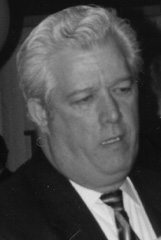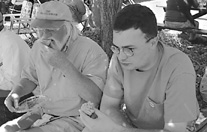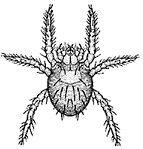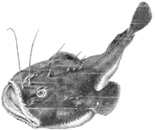
Dock of the Bay

Volume VI Number 31
August 6-12, 1998
Among Green Endorsements, Evans Trumps Gary in AA County
 As
the election draws nearer, Anne Arundel County Executive John Gary has been
trumpeting his environmental credentials to any who'll listen.
As
the election draws nearer, Anne Arundel County Executive John Gary has been
trumpeting his environmental credentials to any who'll listen.
But the Sierra Club must not have been listening judging by their endorsement this week of council member Diane Evans for executive.
"She has embraced many of the ideals we embrace. In her tenure on the county council, she has done a lot of good things," said Joan Willey, political chair.
Evans renounced her membership in the Republican Party to challenge Gary, who she often criticizes for alliances with pro-development interests.
Gary has made no secret of his backing for development but in recent months he has stressed his support for conservation projects, among them the preservation of a 477-acre tract of land on Shady Side Peninsula that was scheduled for residential development. Gary has pledged $3 million of county money to convert the parcel into a park.
 Meanwhile, just one
member of the Maryland General Assembly--- Dist. 30 Del. Virginia Clagett
(D) -- won the endorsement of the Sierra Club and Maryland League of Conservation
Voters. Clagett, who scored a 100 percent environmental rating this session,
was referred to by Willey as "an environmental champion."
Meanwhile, just one
member of the Maryland General Assembly--- Dist. 30 Del. Virginia Clagett
(D) -- won the endorsement of the Sierra Club and Maryland League of Conservation
Voters. Clagett, who scored a 100 percent environmental rating this session,
was referred to by Willey as "an environmental champion."
The only other Anne Arundel legislator who scored 100 in the green rating was Dist. 33 Del. Marsha Perry, who is retiring.
The groups also endorsed two local challengers -- Richard D'Amato in Dist. 30 and Mary Rosso in Dist. 31.
Willey said that she was disappointed that several General Assembly members from Anne Arundel districts failed. "We expect our elected representatives to work for a clean, safe and healthy environment and we find it inexcusable that the majority of our delegation scored failing grades," she said.
Other delegates and their "failing grades" included: Dist. 31 Dels. John Leopold (R) -- 66; Joan Cadden (D) ---33; and Victoria Schade (R) -- 16.
Also: Dist. 30 Dels. Michael Busch (D) ---30; Phillip Bissett (R) --- 0; and Dist. 33 Reps. Janet Greenip and Robert Baldwin, both 16.
In county council races, the Sierra Club Anne Arundel Group announced these endorsements:
Willey said that Klocko "has a fairly good environmental record, which is fitting for that part of the county. He listens to the people of South County."
-NBT
Letters from Lost Towns: A Provident Visit
by James G. Gibb
Despite dark threatening clouds, we're ready to dig.
Before loading up the four trucks and one car, Anne Arundel County Archaeologist Al Luckenbach counts heads: five staff archaeologists of The Lost Towns Project, four volunteers, a college intern and two local high school interns. We are on our way to Swan Cove, an early Colonial site that lay near the heart of Providence, the 1649 Puritan settlement that, wrestling the charter from St. Mary's, became first Maryland's second capital and later Annapolis.
For nearly three years I have been eager to see the site for myself. Not just see the spot but undertake excavations to add to the tantalizing but small collection Al recovered from Swan Cove several years ago. I knew if we could just get out there and begin a test unit or two, Swan Cove would rise on our list of priorities and we would take up again the study of this 350-year-old site and its occupants.
We convoyed up Route 50 to the Broadneck peninsula just as the lightning cracked and the summer skies opened. Prospects looked grim. Eventually, the long drive opened into a small parking area in front of a neat modern ranch house. The property owner, our host for the day, welcomed us with no more instructions than close the pasture gate on our way in and out to keep the two horses from escaping.
Into the pasture at a small concrete block stable, we came upon it: the Swan Cove site, home of Quaker Emanuel Drew and his sons Thomas and Samuel, according to staff historian Tony Lindauer, from 1665 until the 1670s. A possible Drew descendent, Henry Merriday, may have occupied the site at least since 1707, and possibly much earlier. Earlier owners were William Piper (a.k.a. Pyther), Captain William Stone, and Hugh Drew (the latter two Quakers), but no archival or archaeological evidence has yet surfaced to indicate that any of them resided at Swan Cove.
The rain had nearly stopped, but a wall of dark clouds sped in as we examined the area where Al and Tony excavated nearly five years ago. The corners of the adjoining 5 x 5-foot squares were still visible. Those units exposed a midden - a layer of dark silt loam and trash - that yielded hundreds of 17thcentury ceramic sherds and tobacco pipe fragments. The pipes were of particular interest. They looked just like those made in England during the middle part of the century, but they were brown to buff to pink rather than the ash to white color typical of European pipes.
Reading Emanuel Drew's probate inventory - a list of his possessions compiled upon his death for inheritance and tax purposes - showed that he owned two brass pipe molds. The pipe bowls recovered from the site, as it happened, represented two different styles; pipes manufactured from two different molds. Did Drew make and sell tobacco pipes? Could we identify the products of his kiln at other Providence sites?
These and other questions kept the crew working in an intermittent rain. The grass was slippery, the soil muddy. To further complicate matters, Jelly Bean, a fouryear old mare-tested our patience. She attempted a series of petty thefts: a fivepound steel mallet, one of Al's windshield wipers, a rope. Gray skies, wet clothes, mud, and an illbehaved horse notwithstanding, spirits remained high. The two new excavation units produced a fair number of ceramic sherds and tobacco pipes, including mostly earthenware sherds from North Devonshire - in England's West Country, just south of Wales - and Rhenish stoneware jug and mug fragments from Germany. Part of a spoon, large earthenware ceramic sherds of unknown origin, glass wine bottle fragments, a large number of handwrought nails and many brick fragments round out the collection.
Success! We demonstrated that at least part of Swan Cove escaped destruction from plowing and grading, and we collected a modest sample of artifacts that would contribute to our analysis and reconstruction of the lost town of Providence. Conditions would also be suitable for our ground penetrating radar. This sophisticated bit of electronic wizardry potentially can discover the locations and outlines of buildings without disturbing the ground. Jane Cox and Liz West, our geophysical surveyors, will conduct a survey of the Swan Cove site in the not-too-distant future. Perhaps these two futuristic archaeologists will discover not only the dwelling and outbuildings of the Drew family, but the kiln site in which the elder Drew - possibly Anne Arundel County's earliest European manufacturer - made tobacco pipes.
James G. Gibb is assistant director of The Lost Towns of Anne Arundel Project. In his monthly "Letters from Lost Towns," he tells New Bay Times about the latest finds from London, Providence and several other sites in our midst where all-but-forgotten Colonial towns once stood. In earlier letters, Gibb recounted the seesawing fortunes of William Brown, builder of the stately brick mansion overlooking the South River that is the heart of reconstructed London Town, in Edgewater. This is his third letter.
Learn more about ancient Providence from Lost Towns Project Director Al Luckenbach's book, Providence, 1649. Catch up with modern Providence, Greenbury Point, in this week's "Commentary."
Crab Days Are Here Again: Celebrating Callinectes Sapidus
photos by Kim Cammarata Annapolitan Lillian Brown serves samples of her prize-winning softshell BLT, below.
Lively bluegrass music tickled the ears and spicy
steamed crabs perfumed the air August 1 as the three Best Ever Crab Recipe
Contest finalists assembled at the Chesapeake Bay Maritime Museum's annual
Crab Days festival in St. Michaels. Spectators crowded three deep to get
a glimpse of the contestants at work in the outdoor, makeshift kitchen in
the shade of a maple tree.
These three finalists were hand-picked from a field of 50 recipes. Museum volunteer Dick Ford, a frequent winner of recipe contests in years past as well as a former restaurateur, pored through the entries to choose the best three.
First place winner Betsy Hedeman, from Relay, Md., just outside Baltimore, impressed all four judges with her Rehearsal Dinner Crab: jumbo lump crab meat enrobed in a creamy sauce seasoned with mustard, nutmeg, horseradish and sherry and served in puff pastry shells.
She invented this winning recipe for her daughter's wedding rehearsal dinner. A veteran of many cooking contests, Hedeman also captured first prize at the 1983 National Hard Crab Derby in Crisfield with her crab cake recipe.
Cooking contest judge Whitey Schmidt, Maryland's homegrown authority on cooking and eating blue crabs, relished Hedeman's creation.
"You eat with your eyes as well as your mouth. Her recipe looked good," he says. Schmidt equally enjoyed the fine taste of sherry and the overall mellow flavor of the dish. Schmidt ought to know: he's eaten in 275 crab houses and every restaurant on the water around the Chesapeake Bay and has authored numerous cookbooks about blue crabs and Bay cooking.
The other two dishes were so good the judges couldn't favor one over the other. Instead they announced a tie for second place.
Debbie Holland of New Church, Virginia prepared Crabbies: cheddar cheese spread studded with jumbo lump crab meat and spiked with a healthy dose of Old Bay seasoning, then broiled atop English muffins and garnished with fresh basil.
Annapolitan Lillian Brown offered Ultimate Soft Crab Sandwich: a soft-shell crab dredged in Old Bay-seasoned flour and cornmeal then fried golden brown in bacon fat and assembled on rye bread spread with Dijon mustard along with bacon, lettuce and tomato.
Brown had never competed in a cooking contest before. She didn't need to look far for a delicious entry; her soft-shell crab sandwich recipe has been in her family for years. "It's a recipe that my dad used to cook when I was young," she said.
Crab veteran Schmidt got a taste of something new. "It was the first soft crab I ever had that was completely prepared in bacon. It gave it a nice flavor."
Judge Whitey Schmidt, left, gets a little
help from a friend, at left.
After the contest, as a crowd hovered around her cooking station hoping to sample the leftovers, Brown said maybe she'll enter the contest again next year with another crab recipe. "I've got many of them," she says.
Judging from the overflowing food tent, Crab Days' most popular activity was -- no surprise here -- eating crabs. Festival-goers munched on steamed crabs, soft crab sandwiches, crab cake sandwiches and crab soup plus a variety of other food and drink.
Many visitors took full advantage of a host of other festival activities
and demonstrations. Crabbing activities such as trotlining for crabs aboard
the Jackson Skiff and pulling up crab pots at the Waterman's Wharf exhibit
attracted plenty of people.
All-day demonstrations included 'Miss Alice' Palmer's crab picking techniques, crab net knitting by Wilson Roe, knot tying and marine engine repair.
The Hooper Strait Lighthouse drew people like fireflies to enjoy the view while Wes Stone, a living historian from Solomons, described the lonely life of a 1910 lighthouse keeper.
'Miss Alice' Palmer shows how to pick a crab, right.
Children clambered all over the Katie G, a kid-sized version of a work boat, complete with a pretend trotline full of blue felt crabs. Kids climbed in and out of a human size crab pot, made crafts, listened to stories and joined a scavenger hunt among many other activities.
Museum volunteers crawled the grounds, always ready to explain any of the museum's many exhibits or to answer a question. Volunteer John Pynn educated visitors to the Small Boat Shed exhibit about the history and significance of the many crafts housed there.
All in all, the Chesapeake Bay Maritime Museum's Crab Days festival was loads of fun, education and good food for all.
-Kim Cammarata
Old Ways and School Days: Shady Side School Reunites
"Overwhelming," says organizer Yvonne Matthews of advance response to this Saturday's reunion in Shady Side of students, principals and teachers from the old combined Churchton and Shady Side elementary school for blacks.
"People are still calling and giving us their encouragement," says Matthews.
Matthews and Doris Brown -- both former teachers at the Shady Side School -- put the word out by newsletter to local church congregations and advertisement on cable television. "Surprisingly, we're hearing from a lot of people out of the area. Someone just called from Carroll County and we had a call from Philadelphia. People tell me they're hearing about the reunion through the grapevine," Matthews said.
Matthews expects some former students from the 1920s, the school's earliest years. She also hopes parents will bring their children "so these youngsters can learn how it was when we went to school, things like how we had to carry in coal for the pot belly stove."
Saturday's event will warm up with a program of gospel songs from the Spiritual Vibrations, a local group. Former school administrators and students will be introduced by class year. Mementos and photos --"You would really laugh if you could see some of these photos," Matthews says -- will be displayed. After the formal program, there'll be salads, hot dogs and more refreshments.
About the only thing lacking is someone to make a video of the Shady Side Elementary School reunion at Lula G. Scott Community Center in Shady Side starting at 3pm on Saturday, Aug. 8. If you're the one -- or if you want to come -- phone Matthews at 410/867-1727.
-M.L. Faunce
Try this bit of August fun: Next time you're out moseying through a cool, shady meadow, sidle up to a patch of tall grass. Next, with socks pushed down and pants pulled up, jump right in.
After a few hours, look down at your ankles. See welts rising? You've
learned how to get a case of chiggers.
Such fun it is, as anyone who has danced with chiggers can attest.
"I thought I was going to die. I wanted to cut off my arms and legs. I wanted to shave my head," recalls Amanda Spake of Shady Side, who got a full dose of the crimson devils last year while tending iris beds in her back yard. "They were all over. I'd get them in my hair when I bent over to weed. I had dozens and dozens of welts. It got so bad I was pouring alcohol over my head."
For Spake, who was prescribed antihistimines for relief, trying to learn what was tormenting her made the ordeal worse. "Each summer, I'd get these same strange rashes that would just get worse and worse. My doctors weren't much help; they thought it was something internal. None of them could tell me what it was." Since the welts didn't show up for 24 to 48 hours after working in the yard, Spake never made the connection, either.
Finally, she compared rashes with a nurse friend, who had similar woes. "She took one look at mine then said, 'Yep, you've got chiggers, too.'"
In case you've never crossed paths with the beasts, chiggers - otherwise known as redbugs or harvest mites - are microscopic larval stages of a tiny redTrombiculidae mite. As arachnids, chiggers are kin to likes of spiders, scorpions and especially ticks. Unlike their perpetually evil cousin, the tick, only the larval stage of chiggers is parasitic, feeding on animal hosts - including reptiles and amphibians - for protein.
In one of the pest world's rare shows of mercy toward us thin-skinned types, the mites switch to a diet of bugs and bug eggs in their later nymph and adult stages, leaving host-hopping to the next generation of hellions.
What's the best place to catch these tiny entertainers? Chiggers lurk in areas of tall grass, clustering around damp, shady "transition zones" where small wild animals are abundant: ponds, stream banks, ditches, wild berry patches, pastures, treelines - or in Amanda Spake's case, the overgrown empty lot next door.
There, they climb atop plant stems and blades of grass to await a passing host. Once aboard the host (you), they seek out sock tops and waist bands as well as thin-skinned spots: ankles, backs of knees, the groin (heaven help you), the scalp. There they get down to business.
Despite what you may have heard, chiggers don't burrow into your skin; they lack the tools for that. Instead, their mouthparts latch onto your skin at the opening of a hair shaft. Powerful enzymes in their saliva then dissolve your skin cells, forming a nutritious slurry that the chiggers slurp up. Because your body doesn't like to be dissolved, small itching welts soon appear as your body reacts. The longer a chigger feeds, the greater the welt and the worse the itching, which some have likened to a poison ivy rash and others say is the worst itch they've ever felt.
If left alone, the chigger larvae can continue to feed for up to four days, after which they will drop off to complete their growth on the ground. The itching, however, may continue for up to two weeks after chigger is gone.
While chiggers don't carry diseases here in North America, scratching the welts can lead to infection, doctors say. To prevent infection, apply alcohol then topical anesthetic to the welt. Also, a dab of calamine lotion or baking soda paste on the welt will ease the itching.
Put away the nail polish, however, which according to one folk treatment is used on the welt to kill the chigger. Experts say that by then, the chigger is likely long gone.
Just as Amanda Spake discovered the hard way, prevention is the best defense against chiggers.
"Whenever I go out in my yard, I wear long pants, long-sleeved shirts, and a hat, and cover all my clothes with super-dooper insect repellant that has 25 to 30 percent concentration of DEET," she explains. Her advice is sound.
If itching till you're raw is not on your entertainment calendar for August -- and you aim to keep it that way ---here's what you should and should not do with yourself while chiggers are in town:
If you've been out romping in chigger country, change your clothes as soon as possible, laundering them in hot soapy water. Take a bath or shower immediately, thoroughly scrubbing with hot soapy water. If you can't take a bath, however, rub down with a towel; chiggers are easily knocked off.
On the other hand, if you're still looking for the supreme of summertime scratching, chigger populations peak between now and early September. Catch them while they're hot.
-Don Kehne
In Cape May, N.J., tourists are draining town's water supply. The surge in a thirsty summer population -- from 4,500 to 40,000 people -- has lowered the aquifer and caused salt contamination in town wells. As a result, Cape May is the first city in our region to install a desalination plant, which is hiking annual water bills by $85 per family and $9,000 per hotel, the New York Times reports ...
In New Mexico, the man who bilked with his "California Red Superworms" that supposedly devoured nuclear waste and nasty stuff must have a super lawyer: He received probation last week as long as he reimburses his victims ...
Palo Alto, Calif. surely must be the first
city in the nation to offer valet parking for bicycles. The free service
at its CalTrain commuter station is aimed at keeping people from
taking their bikes on trains ...
In Idaho, artist Gregg Schlanger's idea sounds a bit fishy to us. He wants to build a 900-mile long sculpture -- consisting of 150,000 aluminum sockeye salmon -- that stretches from the Pacific Ocean to Redfish Lake, Idaho. There's a message here: Because of pollution and development, no sockeyes have returned to Idaho to spawn for three seasons ...
Our Creature Feature is a fish story nonpareil from Zihuatanejo, Mexico, courtesy of an L.A. Times sports section we found on our airplane last weekend. Pennsylvanian Stan Lushinsky was fishing recently off the coast when he and his pals hooked an 1,100 pound black marlin, which towed them 25 miles -- so far that they ran out of gas, beer and fried chicken.
They landed the fish and survived to tell this story and others to make the point that Zihuatanejo (pronounced zee-wah-tah-NE-ho), up the coast from Acapulco, is the finest and most affordable fishing spot in the hemisphere.
Our favorite was the mysterious creature Lushinsky pulled up from the depths after an earthquake. It had the flippers of a seal, the head of a shark, four small feet and poisonous spines. Turned out it was a rare pescaraton, which locals call a ratfish.
| Back to Archives |
Volume VI Number 31
August 6-12, 1998
New Bay Times
| Homepage |